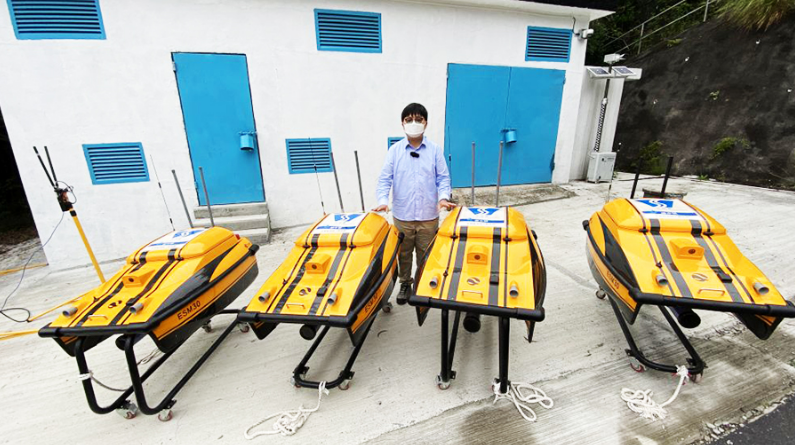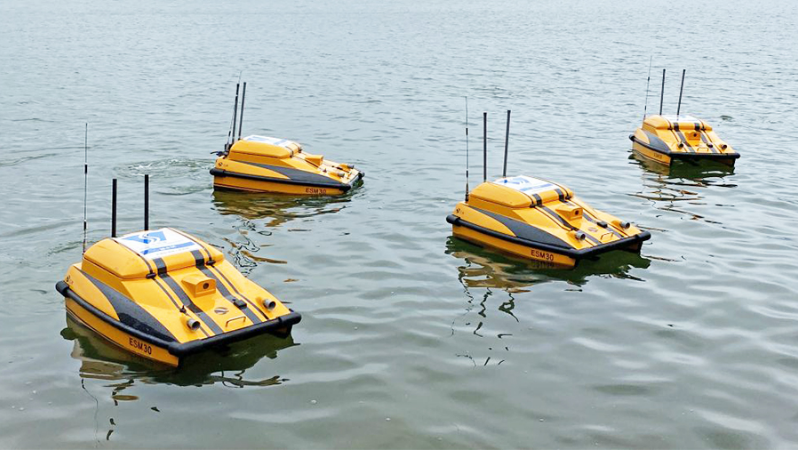To further enhance drinking water safety, the Water Supplies Department (“WSD”) of Hog Kong introduced an Unmanned Surface Vehicle (USV) system from OceanAlpha to perform automatic water quality monitoring and sampling, boosting working efficiency and ensures effective water treatment processes in water treatment works.
Enhancing emergency responsiveness
Currently, there are 17 impounding reservoirs for raw water storage in Hong Kong. The water quality may sometimes be affected by natural environmental conditions or unexpected incidents. For instance, a change of weather may lead to excessive growth of algae that harms water quality. The USV fleet mainly conducts water quality monitoring in the Plover Cove Reservoir (“PCR”), the largest impounding reservoir of Hong Kong, to keep track of water quality and facilitate immediate action in case of emergency.
Equipped with water quality monitoring units
The USV system consists of a base station computer and four ESM30 USVs. Each USV is equipped with a water quality sonde to monitor temperature, conductivity, turbidity, dissolved oxygen, pH, chlorophyll-a and blue green algae. The water sampling unit on each vessel is connected to a pipe underneath that pumps water into the water sampling tank directly. The USVs are also equipped with Global Positioning System receivers and an obstacle avoidance system for navigating around obstacles during operation.
Auto-navigation along a pre-set route
Waterworks chemist of the WSD, Mr Tang Ho-wai tells that, by using the base station computer, the WSD staff can remotely control the USVs to navigate automatically along a pre-set route, monitor water quality and conduct sampling at designated locations. The water quality data collected can be sent to the base station computer in real-time for quick analysis and generation of a surface water quality profile indicating areas with significant variation in water quality for appropriate follow-up.
Endurance for a distance of 11 to 14 km
The four USVs can in a day monitor different parts of the surface of PCR, which is 12 km2 in surface area, and also record the distribution and changes of surface water quality. The vessels are each equipped with a battery that can support the continuous operation of about 3 to 4 hours, which is about 11 to 14 km if converted into traveling distance. However, according to Mr Tang Ho-wai, the longest hours and distance that a USV can actually operate depend on a number of factors, such as settings of the water quality monitoring work, and the day’s wind direction and speed, etc. Based on routine and USV’s monitoring data, the water quality of the PCR has been consistently steady and satisfactory.
Numerous advantages of USVs
Compared with traditional vessels for water quality monitoring, the ESM30 USV system has many advantages. For example, they can be operated by a trained technician, whereas traditional vessels have to be operated by a licensed vessel operator. USVs are smaller in size and can travel to relatively narrow or shallow areas in impounding reservoirs. Moreover, they can simultaneously cover a number of monitoring points for higher efficiency. They can also generate water quality graphical reports with reference to the topographic map of the impounding reservoirs, making it easier to diagnose the distribution and trends of water quality data. With ease of deployment and transportation, the whole USV system can be deployed to work at various impounding reservoirs in the event of water quality emergencies. Furthermore, USVs of the WSD are powered by renewable energy. The WSD has specially installed a solar panel system outside the USV storage house for generating electricity to operate the USVs.
Extension of the project to other impounding reservoirs
Looking forward, Mr Tang Ho-wai says the WSD plans to use USVs at other impounding reservoirs, such as the High Island Reservoir, to monitor water quality and collect water samples. The department will continue to attempt the upgrading of the intelligence of the system, so that it can work in response to real-time water quality data. For example, when certain areas of an impounding reservoir are found to have a higher chlorophyll reading, USVs will automatically increase the number of monitoring points to collect more data and water samples, so that laboratory staff can conduct a more detailed analysis on the quantity and species of algae later in the laboratory.


